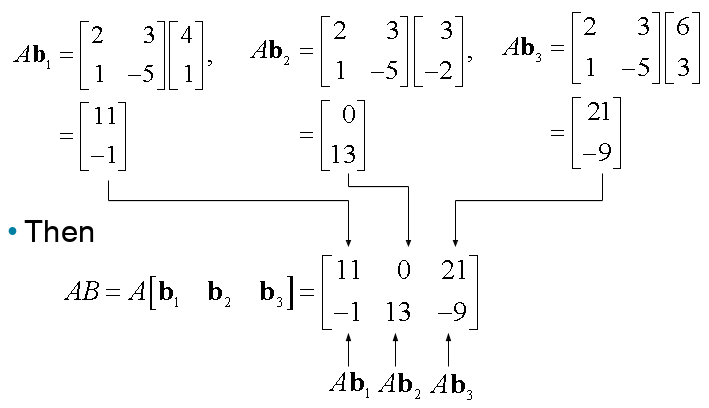Ch02. Matrix Algebra
Matrix Operations
- If is an matrix—that is, a matrix with rows and columns—then the scalar entry in the th row and th column of is denoted by and is called the -entry of .
- Each column of is a list of real numbers, which identifies a vector in .
- The columns are denoted by , and the matrix is written as
- The number is the th entry (from the top) of the th column vector .
- The diagonal entries in an matrix are and they form the main diagonal of .
- A diagonal matrix is a square matrix whose nondiagonal entries are zero.
- An example is the identity matrix, .
- An matrix whose entries are all zero is a zero matrix and is written as .
- The two matrices are equal if they have the same size (i.e., the same number of rows and the same number of columns) an if their corresponding columns are equal, which amounts to saying that their corresponding entries are equal.
Sums and Scalar Multiples
Sum of Matrices
- If and are matrices, then the sum is the matrix whose columns are the sums of the corresponding columns in and .
- Since vector addition of the columns is done entrywise, each entry in is the sum of the corresponding entries in and .
- The sum is defined only when and are the same size.
Example 1
Let , and . Find and .
Solution:
- but is not defined because and have different sizes.
Scalar Multiple of Matrix
- If is a scalar and is a matrix, then the scalar multiple is the matrix whose columns are times the corresponding columns in .
Theorem 1: Let , , and be matrices of the same size, and let and be scalars.
- Each quantity in Theorem 1 is verified by showing that the matrix on the left side has the same size as the matrix on the right and that corresponding columns are equal.
Matrix Multiplication
- When a matrix multiplies a vector , it transforms into the vector .
- If this vector is then multiplied in turn by a matrix , the resulting vector is . See the Fig. 2 below.

- If is , is , and is in , denote the columns of by and the entries in by .
- Then .
- By the linearity of multiplication by ,
- The vector is a linear combination of the vectors , using the entries in as weights.
- In matrix notation, this linear combination is written as
- Thus multiplication by transforms into .
Definition
If is an matrix, and if is an matrix with columns , then the product is the matrix whose columns are .
That is,
Multiplication of matrices corresponds to composition of linear transformations.
Example 3
Compute , where and .
Solution:
Write , and, compute:

- Each column of is a linear combination of the columns of using weights from the corresponding column of .
Row—column rule for computing A B
If a product is defined, then the entry in row and column of is the sum of the products of corresponding entries from row of and column of . If denotes the -entry in , and if is an matrix, then
Properties of Matrix Multiplication
Theorem 2:
Let be an matrix, and let and have sizes for which the indicated sums and products are defined.
- (associative law of multiplication)
- (left distributive law)
- (right distributive law)
- for any scalar .
- (identity for matrix multiplication)
Warnings:
- In general, .
- The cancellation laws do not hold for matrix multiplication. That is, if , then it is not true in general that .
- If a product is the zero matrix, you cannot conclude in general that either or .
Powers of a Matrix
If is an matrix and if is a positive integer, then denotes the product of copies of :
If is nonzero and if is in , then is the result of left-multiplying by repeatedly times.
- If , then should be itself.
- Thus is interpreted as the identity matrix.
The Transpose of a Matrix
- Given an matrix , the transpose of is the matrix, denoted by whose columns are formed from the corresponding rows of .
Theorem 3:
Let and denote matrices whose sizes are appropriate for the following sums and products.
- For an scalar ,
The transpose of a product of matrices equals the product of their transposes in the reverse order.